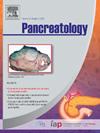Risk of and factors influencing the progression from acute to recurrent acute to chronic pancreatitis
IF 2.7
2区 医学
Q2 GASTROENTEROLOGY & HEPATOLOGY
引用次数: 0
Abstract
Objectives & Aims
Acute pancreatitis (AP) recurrence rates range from 11 to 36 % yet accurately predicting recurrent acute pancreatitis (RAP) and its progression to chronic pancreatitis (CP) after an initial episode remains challenging. Thus, this study explored the risk factors contributing to RAP and its progression to CP.
Methods
This retrospective study included patients with AP from three tertiary medical centers between January 2010 and December 2017. The patients were followed up for up to 60 months. The primary endpoint was the incidence of RAP and CP; risk factors influencing these outcomes were also identified.
Results
Overall, 501 patients were included, of which 164 (32.7 %) experienced RAP, and 71 (14.2 %) progressed to CP. The leading causes of AP were alcohol consumption (43.1 %), gallstones (41.5 %) and hypertriglyceridemia (4.4 %). Multivariate Cox regression analysis revealed that smoking (HR, 4.09; 95 % CI, 2.752–6.078, p < 0.001), and organ failure after 48 h of hospitalization (HR, 3.52; 95 % CI, 1.22–10.19, p < 0.02) were significant risk factors for RAP. Significant risk factors for progression to CP included age over 60 years (HR, 5.29; 95 % CI, 1.25–22.47, p = 0.024), smoking (HR, 2.50; 95 % CI, 1.04–6.01, p = 0.04), alcohol consumption (HR, 8.79; 95 % CI, 2.06–37.43, p = 0.003), computed tomography severity index (CTSI) (HR, 1.22; 95 % CI, 1.04–1.44, p = 0.015), and recurrence of AP (HR, 70.69; 95 % CI, 2.61–1914.86, p = 0.011). In alcohol-induced RAP patients, ≥3 recurrences (HR, 4.18; 95 % CI, 1.75–9.98, p = 0.001) was significant risk factor for progression to CP.
Conclusions
Alcohol consumption was the predominant cause of AP and RAP. The severity of the initial AP episode was the key determinant for RAP, and RAP was the most significant risk factor for the progression to CP. Therefore, smoking and alcohol cessation are important to prevent the development of recurrent AP and CP during long-term follow-up.
急性到复发性急性到慢性胰腺炎进展的危险及影响因素。
目的和目的:急性胰腺炎(AP)的复发率从11%到36%不等,但准确预测复发性急性胰腺炎(RAP)及其在初始发作后进展为慢性胰腺炎(CP)仍然具有挑战性。因此,本研究探讨了导致RAP及其进展为cp的危险因素。方法:本回顾性研究纳入了2010年1月至2017年12月来自三个三级医疗中心的AP患者。对患者进行了长达60个月的随访。主要终点为RAP和CP的发生率;还确定了影响这些结果的风险因素。结果:共纳入501例患者,其中164例(32.7%)发生RAP, 71例(14.2%)进展为CP。AP的主要原因是饮酒(43.1%)、胆结石(41.5%)和高甘油三酯血症(4.4%)。多因素Cox回归分析显示吸烟(HR, 4.09;95% CI, 2.752-6.078, p结论:饮酒是AP和RAP的主要原因。初始AP发作的严重程度是RAP的关键决定因素,RAP是发展为CP的最重要的危险因素。因此,戒烟和戒酒对长期随访期间预防复发性AP和CP的发展很重要。
本文章由计算机程序翻译,如有差异,请以英文原文为准。
求助全文
约1分钟内获得全文
求助全文
来源期刊

Pancreatology
医学-胃肠肝病学
CiteScore
7.20
自引率
5.60%
发文量
194
审稿时长
44 days
期刊介绍:
Pancreatology is the official journal of the International Association of Pancreatology (IAP), the European Pancreatic Club (EPC) and several national societies and study groups around the world. Dedicated to the understanding and treatment of exocrine as well as endocrine pancreatic disease, this multidisciplinary periodical publishes original basic, translational and clinical pancreatic research from a range of fields including gastroenterology, oncology, surgery, pharmacology, cellular and molecular biology as well as endocrinology, immunology and epidemiology. Readers can expect to gain new insights into pancreatic physiology and into the pathogenesis, diagnosis, therapeutic approaches and prognosis of pancreatic diseases. The journal features original articles, case reports, consensus guidelines and topical, cutting edge reviews, thus representing a source of valuable, novel information for clinical and basic researchers alike.
 求助内容:
求助内容: 应助结果提醒方式:
应助结果提醒方式:


